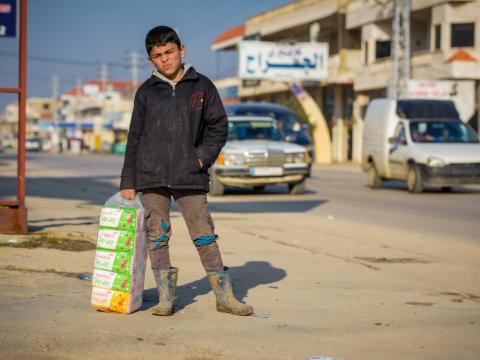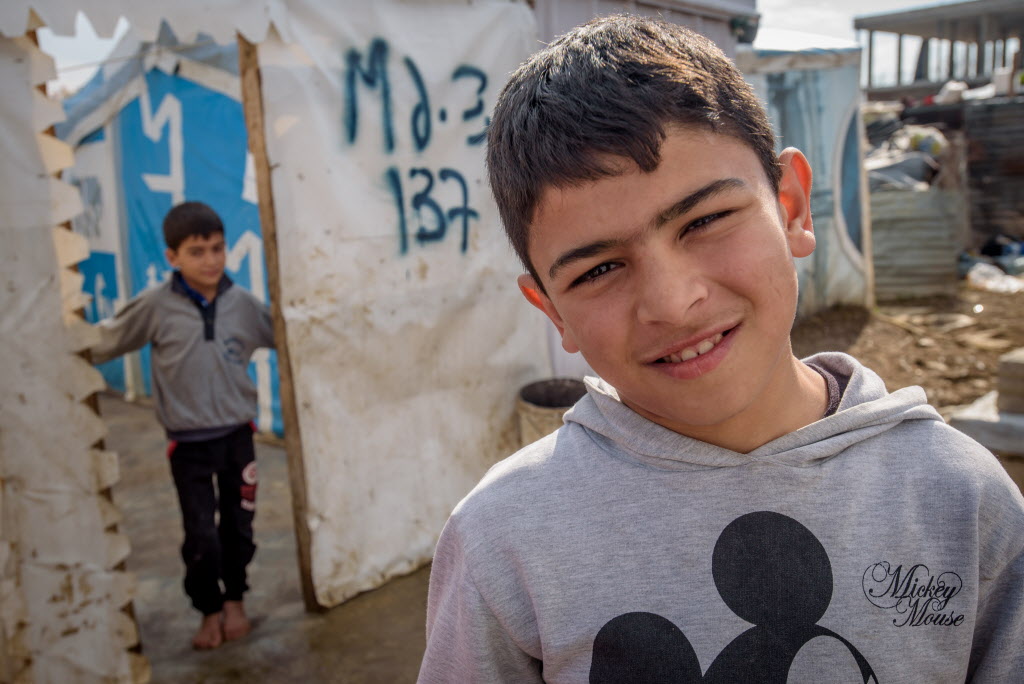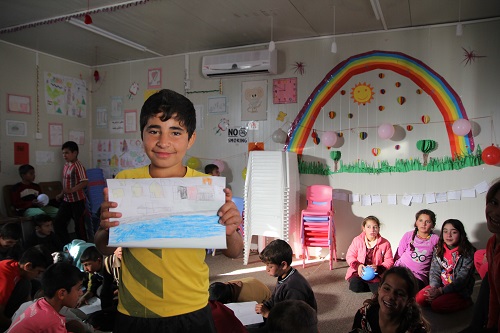The invisible needs of refugee children must be met

Amira is a refugee child and is beaten when she makes mistakes at work. Nour is a daughter forced to labour in a field to help her displaced family. Ali, 13, is a devoted son who has to beg on a street to make ends meet.*
“Help us get out of here so that we can go someplace where we can learn,” says Ali who lives in a run down refugee settlement in Lebanon.
Ali, a Syrian refugee boy in the Bekaa Valley of Lebanon, stands outside his family’s tent. Ali works to support the family and doesn’t attend school. He sells tissues on the busy Beirut to Damascus road. He makes at most $4 a day, which goes toward rent and other family expenses. (Photo credit: Jon Warren / World Vision)
This painful loss of childhood has come about because the education and protection needs of these, and 30 million other children, who have fled fighting and conflict have largely been overlooked and underfunded.
As the world marks World Refugee Day (June 20) it is vital to understand what is happening to the millions of school-age children who are suffering invisible indignities that leave them unprotected and uneducated, and that will have profound implications if ignored.
Last year’s World Refugee Day – an annual event on the humanitarian calendar when the latest forced migration statistics are released – showed 60 million people had experienced forced migration. This year’s figures are likely to top that. While development marches on across much of the world, poverty and violence grip so-called fragile states.
The Syrian crisis shows no signs of abating having already displaced 11.3 million people – over half of them children. In Kenya, the world’s largest refugee camp housing 192,000 Somali children is being shut down by the government, citing security concerns. This situation forces international aid agencies to scramble to decide how to safely return one third of a million refugees to Somalia, a country overwhelmed by conflict and drought.
In places like South Sudan and the Central African Republic, governments barely function and children flee their homes simply to survive. The global impact of El Nino – currently affecting 60 million people, mostly in Africa – is yet to reach its peak. This may prove to be another migration driver.
Despite an increase in displacement not seen since World War II, the special requirements of refugees and migrant children remain overlooked. Humanitarian funding, already inadequate, tends to prioritise food, water and shelter. Less than two per cent of this financing goes toward education. Yet children caught up in humanitarian crises consistently tell us they want to be in school and how important this is to their futures. Children who want to be doctors and teachers are now working as agricultural labourers or scavenging rubbish to help their families scrape by. This is completely unacceptable.
World Vision works with Syrian child refugees in the Middle East and in camps for the internally displaced in places like South Sudan and the Kurdistan Region of Iraq to provide non-formal education and protection.
Read the Let Us Learn case study on our education and protection programming for children in KRI.
Children who attend the Child Friendly Spaces have often witnessed extreme and devastating violence, like the murder of family members or the destruction of their homes. Providing education gives these children a sense of stability and safety, and allows them to start recovering from horrific experiences that have left them withdrawn or prone to aggressive outbursts.
"There hasn't been much water in the camp since yesterday so that's why I drew a river. I liked to swim in the river near where I used to live," said Khalaf, 12. (Photo credit: Suzy Sainovski / World Vision)
But the stark reality is that half of all refugee children are out of primary school, and 75 per cent are out of secondary school. These children are at greater risk of being forced into work, early marriage, an armed group or of being trafficked.
Education is increasingly recognised as the life-saving and protective intervention it is. At last month’s World Humanitarian Summit a new education fund was launched aimed and ensuring more than 13.6 million children and youth living in crisis situations have access to a quality education over the next five years.
Read World Vision's commitment to education made at the World Humanitarian Summit.
Earlier this year, international funding pledges were made in London, UK to ensure all Syrian refugee and host community children have access to an education by the end of the 2016-17 school year.
Helping children forced to migrate to get an education is a monumental challenge that needs to be met with resourcefulness and courage, but there are solutions:
- Governments need to be supported as they grapple with massive demands on their education systems.
- Funding pledges must be met, and investments provided consistently, to prevent stop-start education interventions which plague these efforts.
- Innovative approaches and partnerships are required to help children access education where children and their families are on the move, where schools are too dangerous to attend or where school infrastructure does not exist.
The world is currently failing millions of children caught up in crises. This failure will result in a “lost generation” of psychologically hurt, poorly educated and unproductive members of society if not addressed. It’s time to put children at the heart of our refugee responses.
*Names changed to protect their identities
Related links
- Learn more about World Vision's work to educate children in emergencies.
- BLOG: Outrage and optimism: Education in emergencies is ready for a revolution
- NEWSROOM: More funding for girls' education urgently needed
_________________________________
Linda Hiebert is the Partnership Leader, Education and Life Skills at World Vision International. She has over 25 years of experience in international development, including work as programme officer, director and vice-president in a number of countries and regions. Linda has a Bachelor's degree in Nursing, and a Master's degree in Development from Harvard's Kennedy School of Government.

